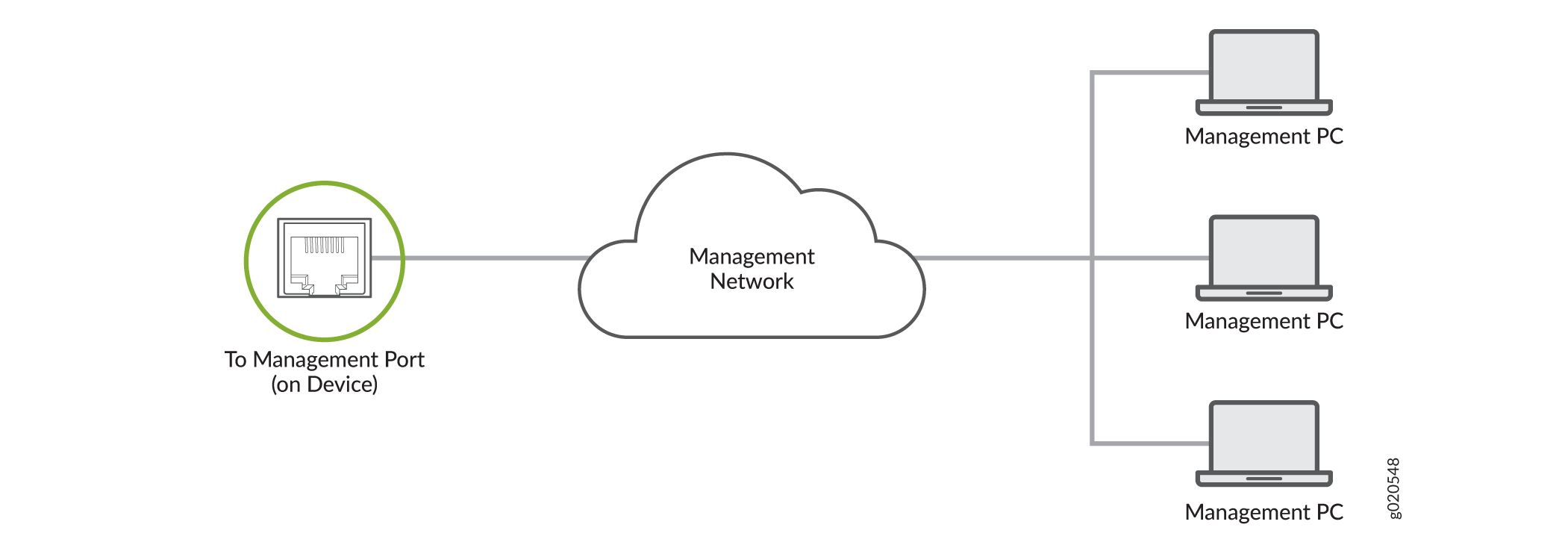Connect ACX5448, ACX5448-D, and ACX5448-M to External Devices
Connect an ACX5400 Router to a Management Console
Ensure that you have an RJ-45 to DB-9 rollover cable available.
If your laptop or PC does not have a DB-9 pin contact and you want to connect your laptop or PC directly to the ACX5400 routers, use a combination of the RJ-45 cable and RJ-45 to DB-9 adapter and a USB to DB-9 plug adapter. You must provide the USB to DB-9 plug adapter.
We no longer include the RJ-45 console cable with the DB-9 adapter as part of the device package. If the console cable and adapter are not included in your device package, or if you need a different type of adapter, you can order the following separately:
-
RJ-45 to DB-9 adapter (JNP-CBL-RJ45-DB9)
-
RJ-45 to USB-C adapter (JNP-CBL-RJ45-USBC)
-
RJ-45 to USB-A adapter (JNP-CBL-RJ45-USBA)
If you want to use RJ-45 to USB-A or RJ-45 to USB-C adapter, you must have an X64 (64-bit) Virtual COM port (VCP) driver installed on your PC. See https://ftdichip.com/drivers/vcp-drivers/ to download the driver.
The ACX5400 routers have a console port with an RJ-45 connector. Use the console port to connect the device to a management console or to a console server.
To connect the ACX5400 router to a management console (see Figure 1 and Figure 2):
- Connect one end of the Ethernet cable to the console port (labeled CON).
- Connect the other end of the Ethernet cable into the console server (see Figure 1) or management console (see Figure 2).


Connect an ACX5400 Router to a Network for Out-of-Band Management
Ensure that you have an appropriate cable available. See ACX5448, ACX5448-D, and ACX5448-M Network Cable and Transceiver Planning.
You can monitor and manage the ACX5400 router by using a dedicated management channel. ACX5400 routers have a minimum of two management ports: a 10/100/1000BASE-T RJ-45 port and a 1-Gbps SFP port. Some models have an additional 1-Gbps SFP port that can be used for either fiber or copper connections. Use the management ports to connect the ACX5400 router to a network for out-of-band management.
Do not configure the two management interfaces within the same subnet.
You cannot use the management ports to perform the initial configuration of the ACX5400 router. You must configure the management ports before you can successfully connect to the ACX5400 router using these ports. See Perform Initial Software Configuration for the ACX5448, ACX5448-D, and ACX5448-M Routers.
To connect an ACX5400 router to a network for out-of-band management (see Figure 3):
- Connect one end of the cable to one of the management ports (labeled MGMT on the ACX5400 router.
- Connect the other end of the cable to the management PC (see Figure 3).

Connect an ACX5400 Router to External Clocking and Timing Devices
The ACX5400 router has two SMB connector ports that support 1-PPS and 10-MHz timing devices.
Ensure that you use a cable of 3 m or less in length for the 10-MHz and 1-PPS connectors.
To connect the SMB to BNC coaxial cable to the external clocking input port:
